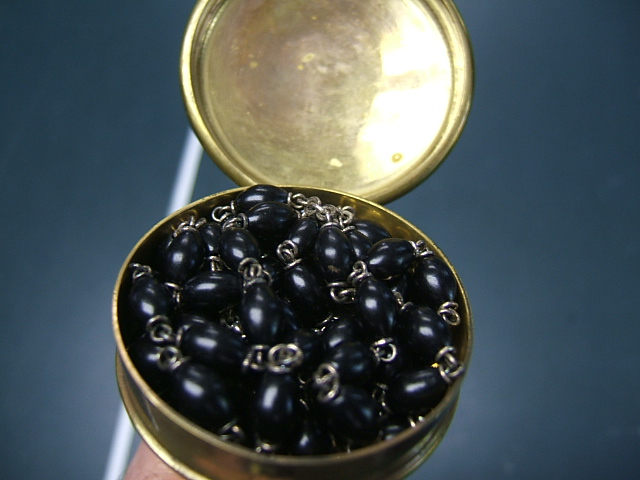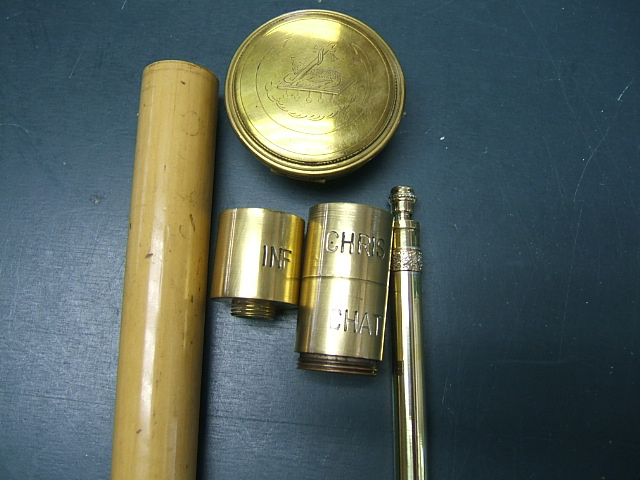 Priest Cane Illustrates The Two Purposes Of Beyond Dike (8988) Priest Cane Illustrates The Two Purposes Of Beyond Dike (8988)
Describing canes is not the purpose of this book. There are two purposes of this book . The first is to teach us how to think about the canes we see, thru the eyes of the people who made them. Of the period, being made when they were supposed to have been made, had a certain set of tools and skill levels. Fads have been here since the beginning of time, and everybody wants what everybody has until everybody has it then nobody wants it. We need to develop a set of expectations of how things were done during different periods. The further we go back the longer it took for change to take place, but the one thing that didnít change is the quality of their work. Letís look at these canes thru the eyes of these craftsmen. The second purpose of this book is to look at canes thru the eyes of the people who carried them. These canes are a reflection of the people who owned them and therefore a reflection of you and I. No one tells us we should like this cane or that one. We just do. I hope you will see yourself a friend or a family member reflected in them. . This priest cane tells us a lot about the Catholic Church and the priest who carried it. First is the metal itís made from, brass. Itís common for our suspicions to increase when we see a brass cane. The acidic reaction of brass to our skin makes it tarnish, and wouldnít be very pretty to carry. The upper classes wouldnít have carried brass. Silver plating wasnít invented until the 1860ís, so you will never see a plated cane older than that. Until I started to write about this cane, I never really examined it closely. I always liked it because of the multiple uses, and there were a number of differences about it than other priest canes I have, or have seen. The first thing I noticed is how few brass canes I have in my collection and those I do have are often from the 1700ís. Then I took this one apart and looked over every piece. I found that on the bottom of the threads there was nickel plate, that it didnít start its life brass. I also determined that it didnít get all brass from wear, that the finish was too even, with no nickel left on the exposed parts. That someone restored it before I got it, as the brass has a number of years of patina. . I donít think I will be as hard on brass canes in the future as I have been in the past, understanding that the plating could have been removed. That does bring up the question of how much not having the original finish should affect the value. I then noticed the lettering on the three holy oil containers below the container top. Most priest canes I have seen have the 3 oil containers in sterling on a shaft. I have seen lots of these as pocket containers. This would be considered a handle made for another use. The letters usually are OI for oil of the sick, SC for christening oil, and, OS for oil of baptism. This is the only one I have seen with these letters. Its obvious what Christi, christening and Inf., sick is, but Chat can only be determined by deduction. When the entire handle is removed, there is a holy water sprinkler also in brass in the shaft. Parts in system sticks have to match; you would never see a silver sprinkler with a brass handle. I have also never seen a brass sprinkler. Iíve only seen sterling, like the one in Dike, which is also a part of a cane that was made for another use, as these were pocket sprinklers; Iíve seen lots of them.
On the lid of the handle is a hand engraved lamb on an alter table with a cross over the lamb and a scarf draped over the cross. The explanation of this to be continued.
The holy water sprinkler was used to bless homes and the families in them. The container was for a rosary, and the oil was to bless the sick, all done outside the church.. There certainly was no need to have them on a cane as they could all fit in a pocket. need was to show others a reflection of who he was, what he did and create a conversation piece. What better way to get people to ask questions, than carry an interesting stick. Nickel plate was popular on canes between 1880 and 1930, because it never tarnished. The simple shape of this cane would put it around circa 1900.
Category: Special
Sub Category: Other
Listed: 2006-07-03 16:38:18
|










 Online Video
Online Video









